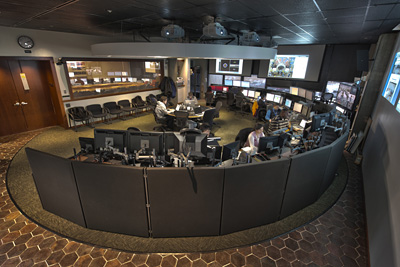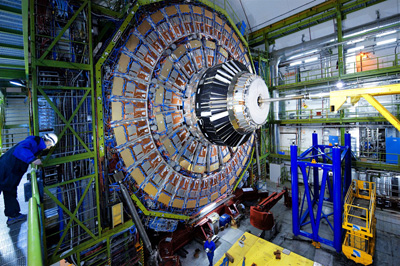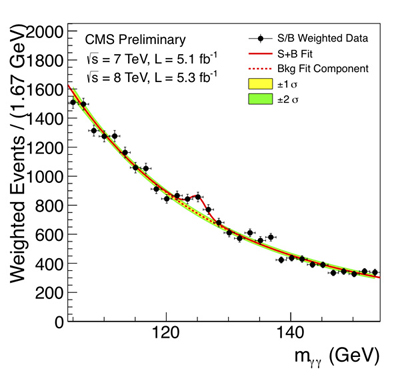Fermilab and the Higgs Boson
Large Hadron Collider Experiments: CMS
On July 4, 2012, scientists on the CMS and ATLAS experiments at the Large Hadron Collider announced the discovery of the Higgs boson. Fermilab was heavily involved in both the construction of the LHC – designing magnets that focus the particle beams into a collision – and the science conducted with the accelerator that led to the Higgs discovery.
Scientists from the United States, including 100 Fermilab employees, make up approximately a third of the CMS collaboration, one of the two main experiments operating on the LHC. Fermilab serves as the hub for U.S. researchers working on the international experiment. Fermilab is home to the LHC Physics Center, a physics analysis hub for physicists from U.S. institutions on CMS. It also hosts the LHC Remote Operations Center, which allows physicists to help operate the CMS detector and monitor the LHC accelerator from afar.
Fermilab serves as a Tier-1 computing center, one of two main computing centers in the United States that store, process and distribute LHC data from CERN. The United States provides 40 percent of the computing power for the CMS experiment, using high-speed networks to transfer data in real time, and Fermilab is the centerpiece of that effort.
Facts
- Number of countries involved in the CMS experiment: 42
- Number of countries involved in the ATLAS experiment: 38
- American institutions make up 33 percent of the CMS collaboration, and 23 percent of the ATLAS collaboration.
- CMS stands for Compact Muon Solenoid, and ATLAS stands for A Toroidal LHC Apparatus. Toroidal means donut-shaped.
- The United States provides about 40 percent of the computing power for the CMS experiment.
- The particle beam circles the Large Hadron Collider about 11,245 times per second.
- The LHC produces about 5.8 quadrillion particle collisions each year.
- One out of every 5 billion collisions in the Large Hadron Collider produces a Higgs boson.
- The Higgs boson got its unofficial nickname, the “god particle,” from the title of a book written by Fermilab’s second director, Leon Lederman.
Links
- US/LHC website
- CMS experiment website
- Fermilab's Energy Frontier page
- Press release: U.S. scientists join “cosmic challenge” at CERN’s Large Hadron Collider (July 2006)
- Press release: Fermilab contributions to CMS magnet at CERN (Sept. 2006)
- Press release: U.S. scientists count down to LHC startup (Aug. 2008)
- Press release: World’s largest computing grid launched (Oct. 2008)
- Press release: Physics begins at Large Hadron Collider (March 2010)
- Press release: LHC experiments eliminate more Higgs hiding spots (Aug. 2011)
- Press release: Possible signs of the Higgs remain in latest analyses (Dec. 2011)
- Press release: Search for Higgs boson at Large Hadron Collider reveals new particle (July 2012)
- Press release: Successful test of new U.S. magnet puts LHC on track for major upgrade (July 2013)
- Video: Fermilab’s Don Lincoln explains the Higgs boson
- Last modified
- 04/28/2014
- email Fermilab




